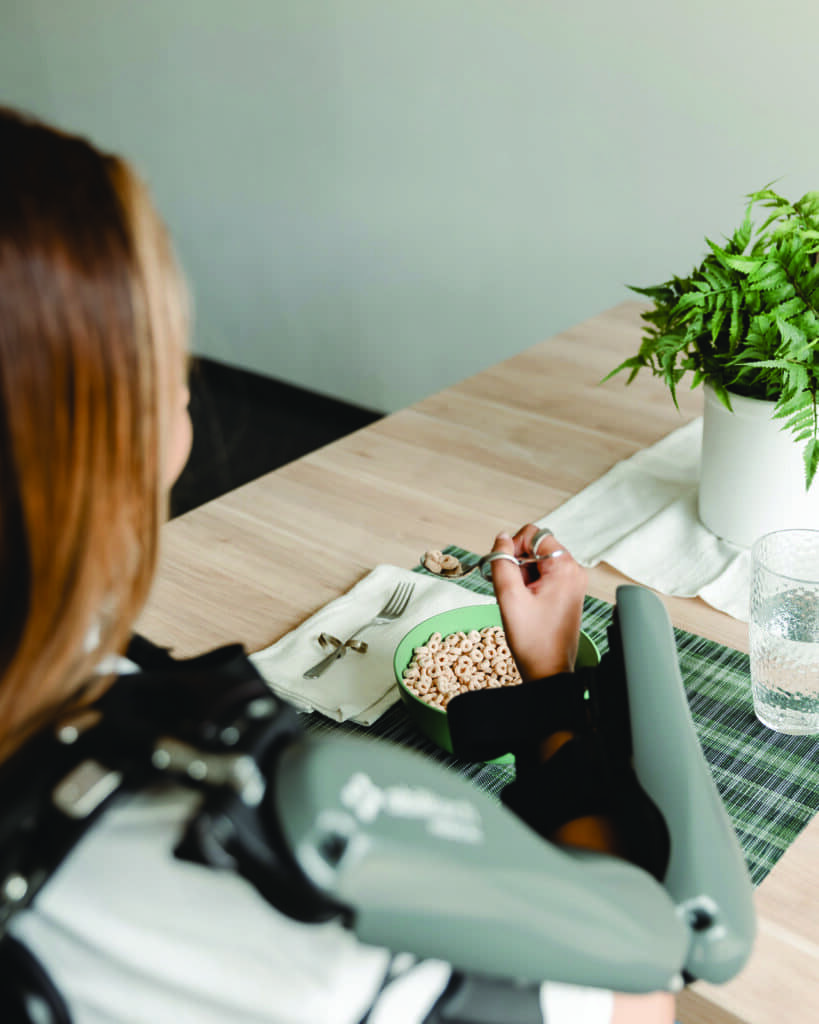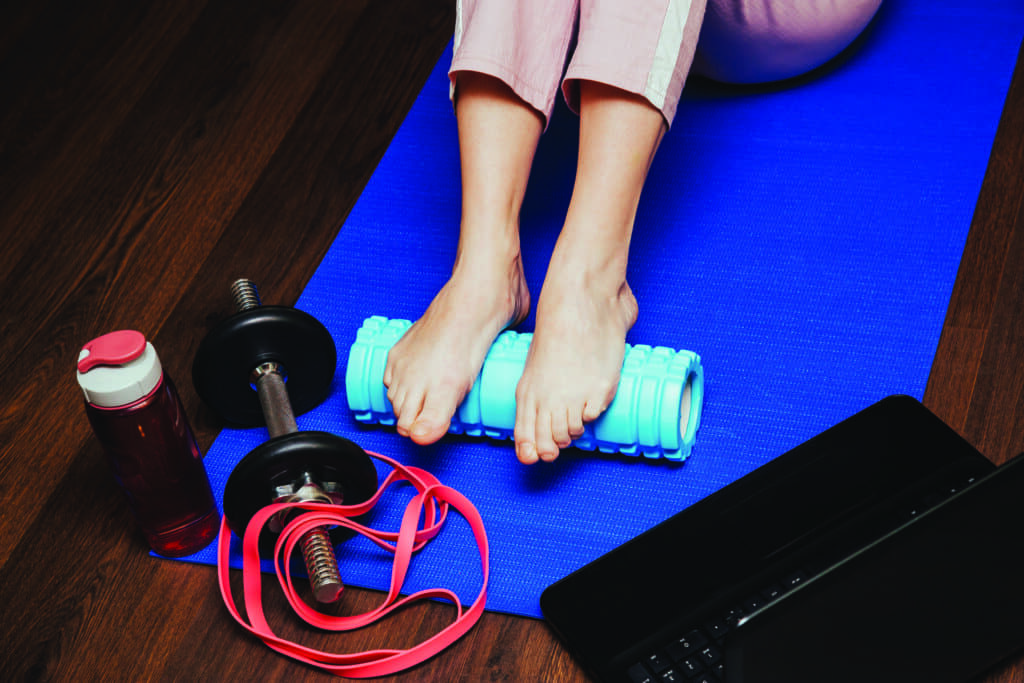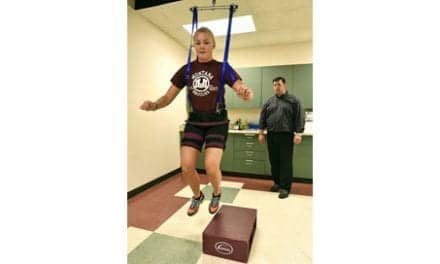PHOTO CAPTION: For patients, telehealth requires the right equipment to replicate the in-person experience. With a TheraBand, patients can safely recreate most exercises that are completed with a pulley or cable machines inside the clinic.
How to replicate in-person, in-clinic treatment over video with a wide spectrum of equipment as telehealth becomes a more realistic treatment option.
By Claire Haeuptle, DPT
Like most professions, physical therapy (PT) adapted by using video to keep functioning in 2020. Therapists and patients were forced to attempt to recreate in-person therapy sessions over the computer or phone.
Telehealth proved important and successful over the past 18 months. Today, there are more telehealth sessions than ever. According to McKinsey, telehealth increased to levels 38 times higher than before the COVID-19 pandemic.1 After a spike to more than 32% of patient visits via telehealth in April 2020, utilization levels have stabilized and now range from 13% to 17% of all visits across all specialties.1
While telehealth has become a more realistic long-term treatment option, it’s not without issues. Conducting PT via video challenges physical therapists to provide safe and effective therapy online. For patients, it requires the right equipment—from simple to sophisticated—to replicate the in-person experience.
Simple
TheraBands from Akron, Ohio-based TheraBand can easily be purchased and used in the home. From banded side stepping to shoulder internal and external rotation, TheraBands provide resistance at multiple levels and have a wide range of uses. With a TheraBand, patients can safely recreate most exercises that are completed with a pulley or cable machines inside the clinic.
Physioballs are great for core and posture exercises. They can also be used for most upper extremity exercises to provide an unsteady surface and increase core contraction. A study on the effects of physioball and conventional floor exercises on early-phase adaptations in back and abdominal core stability and balance in women showed the physioball group had significantly greater mean change in EMG flexion and extension activity and greater balance scores than the floor exercise group.2 Early adaptations in a short-term core exercise program using the physioball resulted in greater gains in torso balance and EMG neuronal activity in previously untrained women when compared to performing exercises on the floor.2
Another piece of equipment great for challenging balance is a foam pad. Patients without one at home can start with a pillow on the ground. To progress, they can purchase a foam pad for a more intense proprioceptive challenge. When using a foam pad, always have the patient next to a steady surface, such as a countertop, so they can catch themselves if needed. Balance exercises on a foam pad should only be completed once the patient has mastered the same exercises on a solid surface. Balance activities are extremely important for the prevention of falls, particularly for older patients.
A foam roller is used for thoracic mobility throughout the day to combat poor posture from sitting for long periods of time. It’s also a great way to recreate some of the self-myofascial release (SMR) techniques done in a clinic. SMR with a foam roller or roller massager appears to have short-term effects on increasing joint ROM without negatively affecting muscle performance and may help attenuate decrements in muscle performance after intense exercise.3 Instructing patients on how to use a foam roller can be a great way to cross the barrier of how to treat a patient without physically touching them.

Standard
Medicine balls are multifunctional and useful in the home, long after therapy sessions are no longer necessary. Sometimes a ball is easier to lift and carry than dumbbells and often requires more total body contraction. Medicine balls can be used in ball slams, air squats, ball presses, and many more exercises. Medicine balls are an effective training tool for building core strength. They work the abdominal muscles and lower back. Many exercises with the medicine ball involve full body movements, which combine cardiovascular and strength training in the same workout. Medicine ball exercises can involve twisting, turning, and bending motions that may not get incorporated into traditional strength training exercises. By incorporating all of the major muscle groups with the muscle stabilizers, medicine ball exercises build functional strength.4
The kettlebell is a versatile weight. This piece of equipment has become very popular, and now there are gyms and exercise classes dedicated solely to the kettlebell. Kettlebells differ from dumbbells in weight distribution and center of mass.
Research has shown that kettlebells are great for adapting power with movements through moves like the kettlebell swing, clean and jerk, and the snatch. The kettlebell is a great piece of equipment for training the return-to-sport athlete at home.
Dumbbells are a more traditional weight and distribute weight equally on both sides. They may provide more stability than other weights and can be easier for increasing weight over time. This is a great option for patients who require heavy lifting to return to work or recreation. Squatting, benching, and deadlifting are a few compound exercises that can be completed with dumbbells in the home to replicate everyday functional movements.
Ankle weights are a great way to add weight to body weight exercises. They aren’t just for the ankles; they can be wrapped above the knees, around the wrists, and above the elbow to create forces at different joints. Another benefit is that ankle weights provide resistance during the entire range of motion, unlike a band, which provides most of the resistance at the end of the range of motion.
Moderate
The BOSU ball, from Ashland, Ohio-based BOSU, is a perfect piece of equipment for challenging balancing activities. Because of its configuration, patients can use the flat or round side in most exercises, depending on the level of difficulty desired. Standing, kneeling, squatting, single-leg balancing, bridging, and core exercises are just a few ways to use the BOSU.
Instability resistance training (IRT) of the upper body using the BOSU may help improve stability of the shoulder joint.5 IRT may also improve both muscular balance and strength, which is useful in preventing sports injuries and aids in the recuperation of individuals who cannot withstand heavier loads or high resistance.5 BOSU IRT exercises have been reported to be effective in decreasing the incidence of low back pain and improving the sensory efficiency of soft tissues that stabilize the knee and ankle joints.5
TRX Suspension Trainer equipment is a more advanced and versatile way to strength train. With this system from San Francisco-based TRX, a patient can complete rows, tricep extensions, bicep curls, pushups, flys, planks, and more, while having to use their core to maintain stability. TRX also allows the patient to complete single-extremity exercises to isolate a weaker side and engage the core to prevent trunk rotation.
Pilates equipment has been adapted for at-home use as well. Collapsible Pilates Reformers are reasonably priced. A Reformer is a system of springs and ropes that provides resistance and assistance during Pilates exercises. The bench platform allows patients to protect their back during exercise while challenging the extremities. Therapists can get very creative with the pulley system of a Reformer and recreate many exercises completed in the clinic for home sessions.
A stationary bike is a great way to warm up the body before a workout, to maintain cardiovascular health, and help with knee and hip joint mobility without repetitive forces loading the joints. A bike is usually a staple of PT and a great way to maintain fitness and health while minimizing the risk of injury.

Sophisticated
Assistive technology, such as powered orthotics or exoskeletons, are now available for home use. One example is the Abilitech Assist device from Eden Prairie, Minn-based Abilitech Medical. This device is indicated for those with neuromuscular weakness of the upper limbs due to injury or disease such as muscular dystrophy, multiple sclerosis, spinal cord injuries, and stroke. This is a unique wearable assistive device that supports patients with upper-limb weakness or injury in completing essential activities of daily living. The Assist is comfortable and easy for patients to use in their homes. It enables patients to use their own strength to move their arms.
For patients with neuromuscular disease or injury, getting to a clinic for therapy can be an all-day task, involving help from caretakers. Assistive devices allow the patient to learn and train for how to accomplish activities of daily living, such as feeding themselves, drinking, using a cell phone, or opening a door, with motorized, intuitive assistance that replicates what a therapist would provide. With repetition and the use of an assistive device, some patients may regain strength and function.
The Assist device has springs at the shoulder and elbow to support the patient’s existing strength for smooth and natural movements of the arm. The device is attached to a vest the user wears while completing activities with the device. This allows for proximal stability with distal mobility to avoid damaging the glenohumeral joint with the new range of motion gained. The Assist can track shoulder and elbow range of motion, frequency and duration of use, and, over time, a therapist can track their patient’s progress and changes in upper extremity function.
Assistive devices are expected to eventually become a mainstay piece of equipment for in-home use by patients looking to regain strength and those living with diseases over the course of their lives.
Conclusion
Our goal as therapists is to rehabilitate patients safely, providing the best level of care possible. Telehealth has become the future of the healthcare field, and we cannot ignore its importance. The prevalence of telehealth in physical therapy requires patients to be properly equipped at home to achieve desired outcomes. Knowing the entire range of what’s available—from standard to advanced—and how to use equipment safely to achieve the benefits each provides, will allow for effective telehealth sessions for patients. PTP
Claire Haeuptle, DPT, has 3 years of experience providing outpatient orthopedic sports rehabilitation in San Diego. She graduated from Rutgers University with her doctorate degree in Physical Therapy in 2018 and her Bachelor’s degree in Biology from the University of Mary Washington, where she played NCAA basketball for 4 years. She is also a Certified Strength and Conditioning Specialist and has completed three separate strength and conditioning internships at NCAA universities. For more information, contact [email protected].
References
- Bestsennyy O, Gilbert G, Harris A, Rost J. Telehealth: a Quarter-Trillion-Dollar Post-COVID-19 Reality. McKinsey and Company. 2020;29.
- Cosio-Lima LM, Reynolds KL, Winter C, Paolone V, Jones MT. Effects of physioball and conventional floor exercises on early phase adaptations in back and abdominal core stability and balance in women. J Strength Cond Res. 2003;17(4):721-725.
- Cheatham SW, Kolber MJ, Cain M, Lee M. The effects of self-myofascial release using a foam roll or roller massager on joint range of motion, muscle recovery, and performance: a systematic review. Int J Sports Phys Ther. 2015;10(6):827-838.
- Vincent J, Traywick LS, Washburn L. Increasing Physical Activity as We Age: Strength Training with Medicine Balls. Cooperative Extension Service, University of Arkansas; 2012.
- Behm D, Colado JC. The effectiveness of resistance training using unstable surfaces and devices for rehabilitation. Int J Sports Phys Ther. 2012;7(2):226-241.





